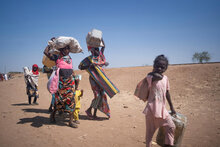Harvest Increases But Food Insecurity Remains High In South Sudan
Food production increased by over 35 percent between 2011 and 2012 due to good rains, improved cultivation practices and expanded area under cultivation, according to the report. That is an improvement over last year’s food security figures, thanks in part to a decent cereal harvest, but it still means that nearly 40 percent of the country’s population will have trouble getting enough to eat at some point during the year. This includes more than a million people who are expected to be severely food insecure.
“South Sudan has tremendous agricultural potential, and the improved harvest estimate is good news, but the country’s overall food security situation remains very precarious,” said WFP Country Director Chris Nikoi. “We must redouble efforts to improve the livelihoods of the poorest and most vulnerable South Sudanese, and ensure they can produce their own food or can afford to buy food to meet their needs, and are more resilient to shocks.”
The FAO-WFP Crop and Food Security Assessment Mission to South Sudan (CFSAM) report is based on an assessment carried out between October and November 2012. It is an important tool in assessing South Sudan’s agricultural production and food availability.
“The CFSAM is our best estimate, but it’s imprecise,” said Dr. Sue Lautze, FAO’s Head of Office in South Sudan. “What we need is a comprehensive agricultural census covering fish, livestock and crops. This would provide a more accurate baseline against which annual production can be more precisely measured.”
South Sudan’s cereal deficit is estimated at 371,000 metric tons for the year, which is about one-third of its total cereal requirement of just over one million tons. Commercial imports will meet some of the “cereal gap,” but the report notes that because of high food prices and poor commercial supply in some parts of the country, a significant amount of food assistance will be required.
WFP plans to provide food and nutrition assistance to about 2.8 million people, including food insecure rural families, vulnerable children, internally displaced people (IDPs), refugees and returnees. This will require about 224,000 tons of food of various kinds.
The report also warns that increased conflict and economic instability could increase the number of people requiring food assistance by more than a million.
Insecurity still remains a major constraint to optimising South Sudan’s agricultural potential. Incidents of armed cattle rustling, conflicts between and among communities, and the activities of militia groups continue to inhibit farmers in affected areas.
FAO is implementing a broad portfolio of agricultural relief and rehabilitation projects as well as longer-term capacity building projects in South Sudan. FAO is also providing livelihood recovery support to IDPs, returnees and vulnerable resident households to increase agricultural production and productivity to improve food and nutrition security, promote peacebuilding, accelerate recovery and lay the foundations for recovery. Some 70 percent of FAO’s seed support will be produced by South Sudanese farmers for distribution to other vulnerable farming households. FAO is seeking US$40 million in donor support through the UN Consolidated Appeal Process (CAP) to support livestock, crop, horticulture, fisheries and agro-forestry humanitarian interventions, as well as its coordination roles.
WFP’s food assistance programmes in 2013 will focus on supporting some 2.8 million of the country’s most vulnerable and food-insecure people, including specialized nutritional support for new mothers and children under the age of five. WFP will assist about 800,000 refugees and IDPs, as well as returnees and poor families in highly food-insecure areas. WFP also supports programmes that address the root causes of hunger, such as infrastructure projects that help the most food-insecure communities increase their agricultural productivity and prepare themselves better to cope with disasters such as floods.
WFP has appealed for US $354 million through the CAP process for its food and nutrition assistance operations in South Sudan this year.
__________________________________________________________
The Food and Agriculture Organization leads international efforts to defeat hunger. It helps countries to modernize and improve agriculture, forestry and fisheries practices and ensure good nutrition for all. FAO focuses special attention on developing rural areas, home to 70 percent of the world's poor and hungry people.
WFP is the world's largest humanitarian agency fighting hunger worldwide. Each year, on average, WFP feeds more than 90 million people in more than 70 countries.
Follow us on Twitter @WFP_Africa AND @FAOnews
For more information please contact:
Sally Cooper, FAO/Juba, Mob. +211 (0) 954 502 836, +211 (0) 927 130 761, Email: Sally.Cooper@fao.org
George Fominyen, WFP/Juba, Mob. +211(0) 922 46 55 37, Email: George.Fominyen@wfp.org
Challiss McDonough, WFP/Nairobi, Mob. +254 707722104, Email: Challiss.McDonough@wfp.org
Read the 2012 CFSAM at:
http://www.wfp.org/content/south-sudan-fao-wfp-crop-and-food-security-a…
http://www.fao.org/giews/english/alert/index.htm.
http://www.fao.org/giews/french/alert/index.htm

